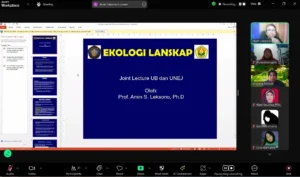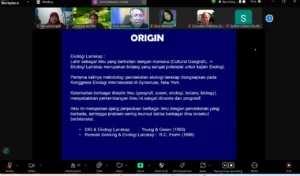 Prof. Amin Setyo Laksono, Ph.D., from Brawijaya University gave a lecture with Master of Biology students, FMIPA UNEJ, and Doctoral Program UB (30/10). Conducted online with tropical biodiversity courses. Discussion on landscape ecology, which is a very potential field for ecological studies. “Landscape ecology is a science that integrates geography and ecosystem approaches on a large landscape scale and various levels of biological organization,” explained Prof. Amin. Furthermore, the structure, function, and changes in landscape ecology were explained.
Prof. Amin Setyo Laksono, Ph.D., from Brawijaya University gave a lecture with Master of Biology students, FMIPA UNEJ, and Doctoral Program UB (30/10). Conducted online with tropical biodiversity courses. Discussion on landscape ecology, which is a very potential field for ecological studies. “Landscape ecology is a science that integrates geography and ecosystem approaches on a large landscape scale and various levels of biological organization,” explained Prof. Amin. Furthermore, the structure, function, and changes in landscape ecology were explained.
“Spatial relationships between different ecosystems or landscape elements in the landscape ecological structure,” he continued. The joint lecture was moderated by Purwatiningsih, S.Si., M.Si., Ph.D., a lecturer in biology at FMIPA. Prof. Amin explained the function of landscape ecology regarding the interaction between spatial elements, namely the flow of energy, matter, and species between ecosystem components or landscape elements. The participants of the joint lecture were enthusiastic to listen to the explanation from Prof. Amin, who is the first Professor at FMIPA Universitas Brawijaya.
The next lesson is a change in discussing landscape ecology. “Alteration of landscape structure and function includes alteration of structure and changing function as well as alteration of function without changing structure,” he said. Prof. Amin explained clearly and with easy-to-digest picture narratives. It was mentioned about landscape elements consisting of patches, matrices, corridors, and edges. Even with the landscape structure, which is influenced by the configuration, composition, and proportion between landscapes.
The discussion reached the principle of landscape ecology consisting of landscape structure and function, biodiversity, species movement, mineral nutrient transport, energy transfer, landscape changes, and landscape stability. At the end of the material, Prof. Amin explained the state of the art in compiling research. “We must understand how to compile the state of the art; it is useful for researchers to more easily understand and analyze research problems; even the research can be used as a reference or not,” he concluded.



